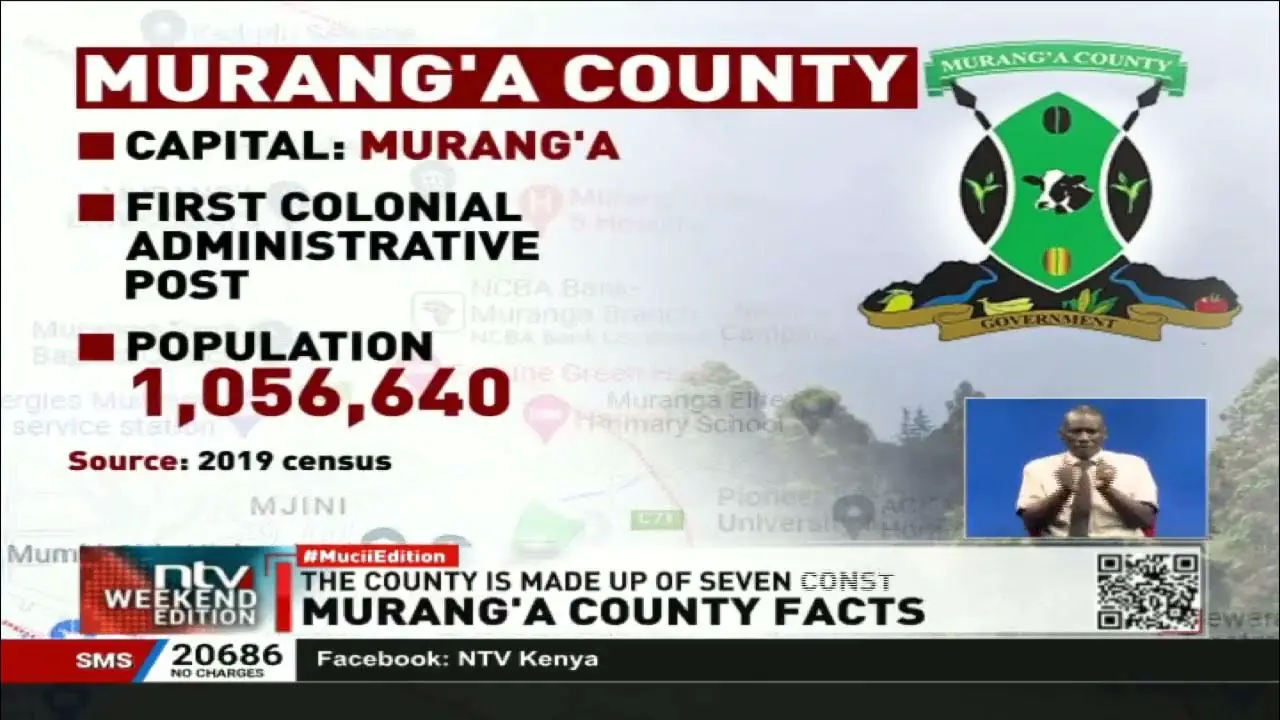Have you ever heard of Murang’a County? Located in the central part of Kenya, this enchanting region is known for its scenic beauty, rich cultural heritage, and vibrant communities. From lush green landscapes to majestic waterfalls, Murang’a County offers a haven for nature lovers and adventure seekers alike. With a diverse range of activities, such as hiking, birdwatching, and exploring historical sites, this hidden gem promises a memorable experience for all who visit. Join us as we embark on a journey to discover the wonders of Murang’a County.

This image is property of muranga.go.ke.
Geography
Location
Murang’a County is located in the central region of Kenya. It is situated approximately 85 kilometers northeast of Nairobi, the capital city of Kenya. The county shares borders with Nyeri County to the north, Kirinyaga County to the east, Kiambu County to the south, and Nyandarua County to the west.
Topography
The topography of Murang’a County is characterized by a combination of highlands, valleys, and ridges. The eastern part of the county is dominated by the Aberdare Ranges, which are part of the larger East African Rift System. These highlands provide a picturesque landscape and also contribute to the formation of several rivers that flow through the county. In contrast, the western part of the county is mainly composed of undulating plains, which are fertile and suitable for agriculture.
Climate
Murang’a County experiences a moderate climate, with temperatures ranging between 10 degrees Celsius in the cold months of June and July, and 28 degrees Celsius during the hot months of January and February. The county receives an average annual rainfall of about 1,200 millimeters, with the long rains occurring between March and May, and the short rains between October and December. The favorable climate, combined with the well-distributed rainfall, supports agricultural activities and contributes to the county’s overall economic development.
History
Pre-colonial era
Before the arrival of Europeans, Murang’a County was inhabited by various Bantu-speaking communities, including the Kikuyu, the largest ethnic group in the region. These communities practiced subsistence farming, rearing of livestock, and hunting. They had well-organized social structures with chiefs, clans, and age sets playing significant roles in governance and community affairs.
Colonization
The arrival of the British in the late 19th century marked the beginning of colonization in Murang’a County. The British established administrative structures and introduced cash crop farming, which led to significant changes in the local economy and social dynamics. Many locals were forced to work as laborers on European-owned farms, while others lost their ancestral lands. This period of colonization, although marked by subjugation and exploitation, also brought some positive developments such as the introduction of formal education and modern infrastructure.
Post-independence
Murang’a County, like the rest of Kenya, gained independence from British colonial rule on December 12, 1963. The county has since witnessed significant progress in terms of development, infrastructure, and governance. The local population actively participates in national politics and has produced prominent political leaders who have contributed to the national development agenda.

This image is property of muranga.go.ke.
Demographics
Population
Murang’a County has a diverse population, with the latest estimates placing it at approximately 1.7 million people. The population has been steadily growing over the years, primarily due to natural increase and internal migration from other parts of the country. The county’s strategic location, fertile land, and favorable climate have attracted people seeking opportunities in agriculture, business, and other economic sectors.
Ethnicity
The Kikuyu community is the predominant ethnic group in Murang’a County, constituting a significant majority of the population. Other ethnic communities present in the county include the Kamba, Embu, Meru, and Luo, among others. The county’s diversity in terms of ethnicity contributes to its rich cultural heritage, fostering mutual respect, and promoting national cohesion.
Languages
The official language in Murang’a County is Swahili, which is widely spoken and understood by the majority of the population. However, the primary language of communication among the locals is Kikuyu, a Bantu language. English is also used in formal settings such as schools, government offices, and business transactions.
Administration
County capital
The county capital of Murang’a County is Murang’a town. It serves as the administrative, economic, and social hub of the county. The town is strategically located and is well connected to other towns and cities in the region, making it a center for trade and commerce.
Sub-counties
Murang’a County is divided into six sub-counties, namely Kandara, Gatanga, Kigumo, Kangema, Maragua, and Mathioya. Each sub-county is headed by a sub-county administrator who oversees the implementation of county government programs and services at the local level.
Wards
The county is further subdivided into various wards, each represented by an elected ward representative in the county assembly. These wards include Kandara, Kangema, Gatanga, Kigumo, Maragua, Mathioya, and Kiharu, among others. The ward representatives play a crucial role in promoting development and addressing the needs of their respective constituencies.

This image is property of i0.wp.com.
Economy
Agriculture
Agriculture is the backbone of the economy in Murang’a County. The fertile soils, favorable climate, and abundant water resources contribute to the high agricultural productivity in the region. The county is known for the production of crops such as coffee, tea, horticultural products, maize, beans, and potatoes. Livestock farming, particularly dairy farming, is also a significant economic activity.
Manufacturing
Murang’a County has a growing manufacturing industry, with small and medium-scale enterprises playing a vital role in job creation and economic growth. Manufacturing activities in the county include food processing, textile and garment production, construction materials, and agro-processing. The county government is committed to supporting and promoting the growth of the manufacturing sector through various initiatives and incentives.
Tourism
Murang’a County has attractive tourist sites and activities that contribute to its tourism industry. The county is home to the scenic Aberdare Ranges, which offer opportunities for hiking, camping, and bird-watching. Other tourist attractions include waterfalls, caves, cultural heritage sites, and wildlife sanctuaries. The county government, in collaboration with private sector players, is working towards promoting tourism and ecotourism as a means to diversify the county’s economy and create employment opportunities.
Infrastructure
Roads
Murang’a County has an extensive road network, connecting its various towns and villages. The county government, in partnership with the national government, has invested in the construction and rehabilitation of roads to enhance connectivity and facilitate efficient transportation of goods and people. Major roads in the county include the Thika-Murang’a road, the Maragua-Makuyu road, and the Sagana-Kagio road, among others.
Water supply
Access to clean and safe water is essential for the well-being of the population in Murang’a County. The county government has implemented various water projects, including the construction of dams, boreholes, and water pipelines, to improve water supply in both urban and rural areas. These initiatives have significantly increased access to clean water for domestic use, irrigation, and livestock farming.
Electricity
Murang’a County is well served in terms of electricity supply. The county is connected to the national power grid, ensuring a reliable and consistent supply of electricity to homes, businesses, and industries. The availability of electricity has facilitated the growth of manufacturing, improved household livelihoods, and enhanced access to modern technology and communication.

This image is property of i.ytimg.com.
Education
Primary schools
Murang’a County has a well-established primary education system, with a wide network of public and private primary schools. The county government, in partnership with the national government, has invested in the construction of school infrastructure and the provision of teaching and learning materials. Primary education is compulsory and free in Kenya, ensuring access to education for all children within the county.
Secondary schools
Secondary education in Murang’a County is also well-developed, with numerous public and private secondary schools spread across the county. The county government has prioritized the improvement of secondary school infrastructure and the recruitment of qualified teachers to enhance the quality of education. Secondary education plays a vital role in preparing students for further studies and equipping them with skills necessary for future employment opportunities.
Tertiary institutions
Murang’a County is home to several tertiary institutions, including universities, colleges, and vocational training centers. These institutions offer various courses and programs, ranging from certificate courses to degree programs. The county government has been actively involved in supporting these institutions through the provision of funding, infrastructure development, and capacity building for the teaching staff. Tertiary education plays a crucial role in equipping individuals with specialized skills and knowledge required in the job market.
Healthcare
Hospitals
Murang’a County has several hospitals, both public and private, that provide healthcare services to the population. The county government has invested in the expansion and upgrading of healthcare facilities, including the construction of modern hospitals and the recruitment of qualified healthcare professionals. These hospitals offer a wide range of services, including maternity care, surgery, laboratory testing, and specialized treatments.
Health centers
Health centers and dispensaries are widely distributed across Murang’a County, ensuring accessibility to healthcare services in both urban and rural areas. These facilities provide primary healthcare services, including immunization, antenatal care, family planning, and treatment of common illnesses. The county government has also implemented community health programs to promote preventive healthcare and raise awareness about various health issues.
Disease prevalence
The county government, in collaboration with the national government and other stakeholders, has implemented various disease prevention and control measures. Common diseases in the county include malaria, respiratory infections, water-borne diseases, and non-communicable diseases such as diabetes and hypertension. Efforts are being made to improve healthcare infrastructure, strengthen disease surveillance systems, and promote public health education and awareness to reduce the prevalence of these diseases.

This image is property of muranga.go.ke.
Culture and Tourism
Cultural practices
Murang’a County has a rich cultural heritage, with the Kikuyu community being the main custodians of the local culture. Cultural practices such as rites of passage, music, dance, storytelling, and traditional medicine are celebrated and passed down from one generation to another. The county government, in collaboration with cultural organizations, promotes the preservation and celebration of the county’s cultural diversity through cultural festivals, exhibitions, and cultural exchange programs.
Tourist attractions
Murang’a County is blessed with numerous tourist attractions that showcase the natural beauty and cultural heritage of the region. The Aberdare Ranges, with their scenic landscapes, waterfalls, and diverse wildlife, attract nature enthusiasts and adventure seekers. Other attractions include historical sites, traditional villages, botanical gardens, and archaeological sites. The county government continues to invest in the development and promotion of these attractions to attract more visitors and stimulate tourism growth.
Festivals and events
Festivals and events play an important role in the cultural and social life of Murang’a County. The county hosts various festivals throughout the year, including agricultural shows, cultural exhibitions, music festivals, and sports events. These events provide platforms for showcasing local talent, promoting cultural exchange, and fostering unity among the residents. The county government actively supports and organizes these events as part of its commitment to preserving and promoting the county’s cultural heritage.
Politics
Political leaders
Murang’a County is represented by elected political leaders at various levels of government. The county governor is the head of the county government and is supported by a team of county executives responsible for different sectors. The county is also represented in the national parliament by elected members of parliament who champion the interests of the county at the national level.
Party affiliations
Political parties play a significant role in the political landscape of Murang’a County. The county has been known to have a strong presence of political parties such as Jubilee Party, which has traditionally enjoyed massive support in the region. However, the county has seen political shifts and realignments in recent years, with other parties and independent candidates also gaining traction.
Election history
Murang’a County has been actively involved in national elections since Kenya’s independence. Over the years, the county has witnessed peaceful election campaigns and turnout of its residents during the election period. The county government, in collaboration with the national government and other stakeholders, works towards ensuring free, fair, and transparent elections in the county, promoting democratic governance and citizen participation.
In conclusion, Murang’a County is a vibrant region in Kenya, boasting a rich cultural heritage, diverse economy, and scenic landscapes. The county’s favorable climate, fertile land, and well-developed infrastructure make it an attractive destination for agriculture, tourism, and investment. The county government, in partnership with the national government and other stakeholders, continues to prioritize development in various sectors, such as education, healthcare, and infrastructure, to improve the well-being of its residents and promote sustainable economic growth.


